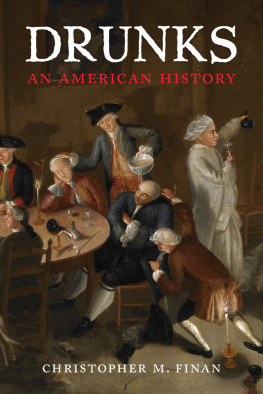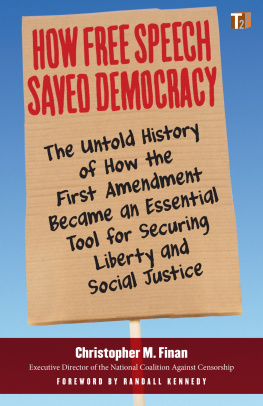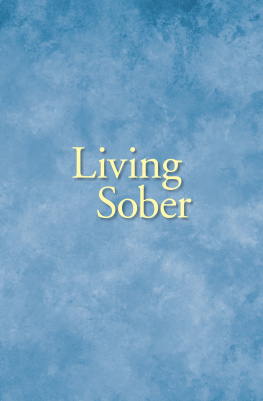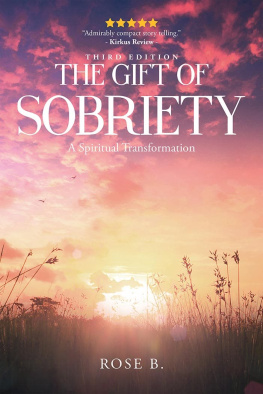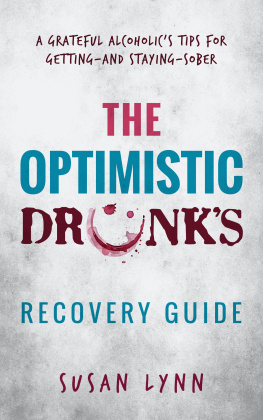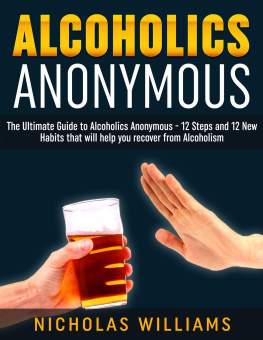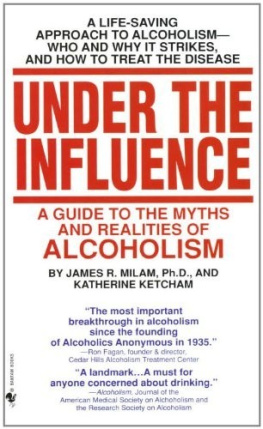ALSO BY CHRISTOPHER M. FINAN
From the Palmer Raids to the Patriot Act:
A History of the Fight for Free Speech in America
Alfred E. Smith: The Happy Warrior

For Sam and Al,
and our family ghosts
INTRODUCTION
PRESIDENT JOHN ADAMS had just discovered his son was an alcoholic. He was furious. Charles had been a handsome and charming nine-year-old when he accompanied his father on a diplomatic mission to Europe in 1779. Charles wins the heart as usual, and is the most gentlemen of them all.... I love him too much, John wrote to his wife, Abigail. But in his midteens, Charles began to display disturbing behavior. While a student at Harvard College, he was caught running across Harvard Yard with several other boys. They may have been naked. They were probably drunk. Charles was able to graduate and became a lawyer, but John and Abigail remained concerned about the character of his friends. His father wrote him many admonishing letters.
John learned the worst in 1799 during a visit to his daughters home. He found Charless wife and two young children living there: the family was bankrupt, and Charles had disappeared. He is a mere rake, buck, blood, and beast... a madman possessed of the Devil, John told Abigail. I renounce him. Abigail did not break with Charles, but she was also angry. When he reappeared, she told him that he was hurting his family and appealed to his pride and sense of honor. But all is lost on him, she said. The whole man [is] so changed that ruin and destruction have swallowed him up. Poor, poor, unhappy, wretched man.
In November 1800, Abigail saw her son for the last time. His body was bloated. He was in great pain and often incoherent. He died a few weeks later at the age of thirty. He was no mans enemy but his own, Abigail said. He was beloved in spite of his errors. But Charles was not buried in the family vault. Let silence reign forever over his tomb, his brother Thomas said.
The countrys First Family was not alone in feeling anger, shame, and guilt over the loss of an alcoholic family member. Americans had always been big drinkers. Even the Puritans had considered alcohol the good Creature of God. Now the creature had turned. Cheap whiskey was flooding the market, and annual consumption of alcohol was climbing toward seven gallons per person, nearly three times what we drink today.
Americans have been frustrated by alcoholism ever since. In 1808, a doctor and a minister organized a temperance society in a small town in upstate New York. Temperance became a national movement, as over two million people signed a pledge not to drink alcohol. When voluntary measures failed, state governments began banning the sale of alcohol, and prohibition was implemented nationally in 1920. Nothing could stop the drinking.
Many people blamed the drunks. Throughout history, they have frustrated every effort to force them to stay sober. In the first century AD, the Roman philosopher Seneca called alcoholism a voluntary madness. Increase Mather, a Puritan minister in Boston, preached two sermons against drunkenness in 1673. It is a sin that is rarely truly repented of and turned from, he said. Blows cannot beat him out of it; but he will to it yet again, and that too the very next day after he hath smarted for it, he wrote. In 1871, a Massachusetts judge declared that drunks deserve no mercy. [T]he great truth... remains that the drunkard is self-made, progressively self-taught, and obstinately self-immolated, he said.
Even after the founding of Alcoholics Anonymous (AA) in 1935 proved that many drunks want to stop drinking, the major institutions of American life refused to help them. Hospitals would not admit alcoholics, turning away even those in need of emergency care. Most doctors, psychiatrists, and psychologists would not accept them as patients. They wound up in insane asylums and jails. The federal government finally recognized alcoholism as an illness in the 1960s, but many people were not convinced. The drunks responsibility for abusing alcohol was still being debated at the dawn of the twenty-first century.
Yet the story of recovery from alcoholism is also one of the oldest in American history. In the same year that John Adams renounced his son, an alcoholic Native American on the verge of death experienced a vision that caused him to stop drinking. Handsome Lake became the leader of a religious revival that significantly reduced alcoholism among the Iroquois people. In 1840, six hard drinkers in Baltimore made their own pledge to stop drinking and founded a group to help alcoholics. Members of the Washington Temperance Society searched the streets of the nations cities for homeless drunks and took them to meetings where they heard men like themselves describe how they got sober.
The Washingtonians were unable to sustain their movement, but they inspired others to open institutions where many drunks got sober. Doctors ran some of these inebriate homes and asylums. In the 1890s, tens of thousands of drunks found help in clinics that dispensed a drug called the gold cure for alcoholism. Others were able to stop with the help of religion. Drunks who had found sobriety played an important role in all of these efforts. In the 1940s, AA members began organizing groups around the United States. There were more than sixty thousand groups in 2016.
The fight against addiction is one of Americas great liberation movements. Like the battles for racial equality, womens rights, and sexual freedom, its history is marked by periods of progress and devastating reverses. Several times, Americans have embraced humanitarianism, rejecting the view that drunks are to blame for abusing alcohol, only to return to the idea that addiction must be punished. Today we are expressing regret for our decision to send millions of addicts to prison during the 1980s and 1990s. Once again, there is hope that a more tolerant age is dawning. But after two centuries of struggle for the humane treatment of alcoholics, the fight continues.
CHAPTER ONE
Mountain of Bones
IN SPRING OF 1799, Handsome Lake, a Native American, joined members of his hunting party in making the long journey from western Pennsylvania to their home in New York. Handsome Lake was a member of the Seneca Nation, one of the six nations in the Haudenosaunee (Iroquois Confederacy). He had once been renowned for his fighting skill. But the Iroquois had been stripped of almost all their lands after the American Revolution. Now fifty years old, Handsome Lake, too, was a shadow of what he had been. He would later say that heavy drinking had reduced him to but yellow skin and dried bones. After stopping in Pittsburgh to trade furs for several barrels of whiskey, the hunters lashed their canoes together and began to paddle up the Allegheny River. Only those in the outer canoes had to work. The rest of the party drank whiskey, yelling and singing like demented people, Handsome Lake said. The good times didnt stop after they picked up their wives and children, who had accompanied them on the hunting trip and were waiting at a rendezvous. Everyone looked forward to being home in Cornplanters Town, named for its Seneca Leader.
The joy of their homecoming did not last long. There was enough whiskey to keep the men drunk for several weeks. Handsome Lake described the horror of that time:
Now that the party is home the men revel in strong drink and are very quarrelsome. Because of this the families become frightened and move away for safety. So from many places in the bushlands camp fires send up their smoke.

